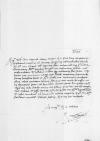List #14
Mercurino Arborio di GATTINARA do Ioannes DANTISCUS[Valladolid], [1524-10-12 — 1524-11-01]
Regest polski:
Gattinara usprawiedliwia opóźnienie odpowiedzi na list Dantyszka wysyłaniem gońca do cesarza. Obiecuje przedstawić cesarzowi sprawę paszportu podróżnego (salvus conductus) wraz z pozostałymi sprawami Dantyszka, życzy sobie jednak, aby polski poseł przedstawił je w formie memoriału, na który otrzyma odpowiedź. Zawiadamia, iż nie dokument testamentu księżnej [Izabeli Aragońskiej] nie jest i nie zostanie w przyszłości potwierdzony.
Honor nie pozwala Gattinarze na zapytanie cesarza wprost o to, czy wolno mu przyjąć od Dantyszka prezent w postaci futer. Kanclerz sugeruje Dantyszkowi, aby poprosił cesarza o zgodę na to za pośrednictwem Jeana Laelmanda lub hrabiego [Hendrika] van Nassau.
Rękopiśmienne podstawy źródłowe:
Pomocnicze podstawy źródłowe:
Publikacje:
| ||||||||||
Tekst + aparat krytyczny + komentarz Zwykły tekst Tekst + komentarz Tekst + aparat krytyczny
Magnifico Domino
Magnifice Domine.
Non respondi statim cf.
De pellibus nullam ego mentionem feci
Valeat interim Magnificentia Vestra, cui me commendo.
Ad mandata Magnificentiae Vestrae deditus

